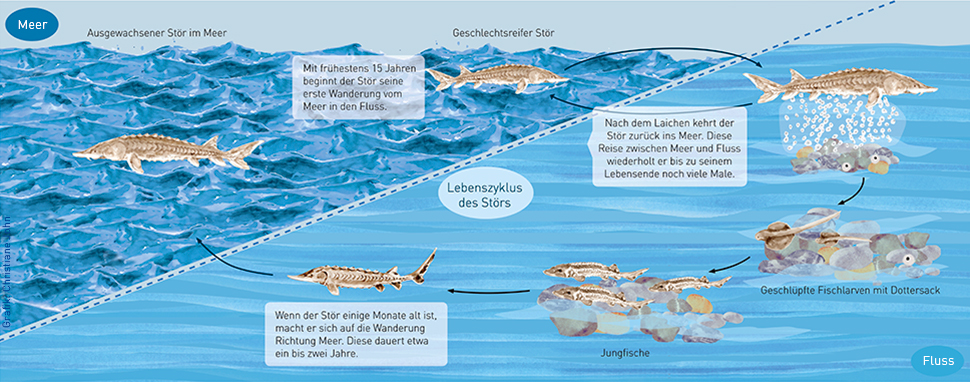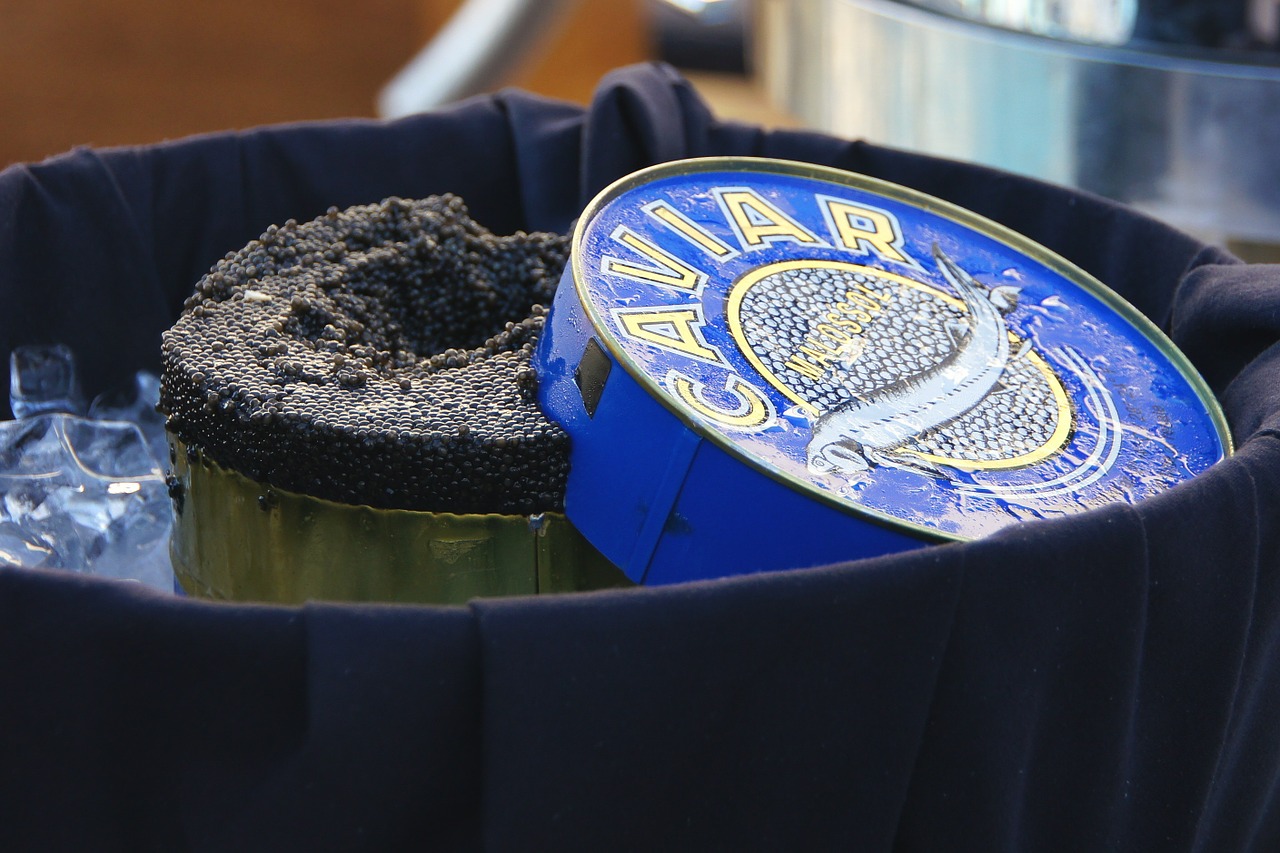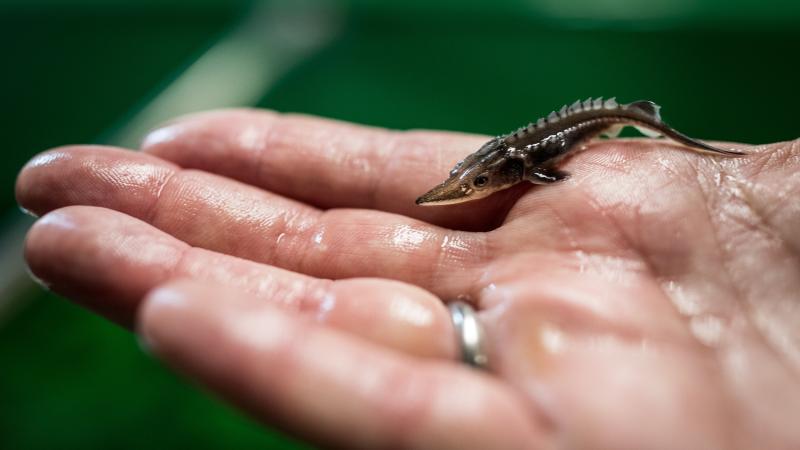
A European sturgeon: On the underside of his head is the protractile, extendable mouth, with which he absorbs his food from the seabed. The barbels in front of his snout help him to feel and taste his food. | Photo: Solvin Zankl
Who is the Sturgeon?
Sturgeons are ancient beings: they have lived on the earth for around 200 million years and have survived huge changes over time, such as continental drift, meteorite impacts and the switch between ice ages and dry seasons. The sturgeon even existed at the same time that dinosaurs inhabited the earth. In the long time-span of their existence, their appearance has barely changed. Their skeleton is not made from bone, but from cartilage, like a shark. In comparison to other fish, the sturgeon does not have scales, but rather a smooth, thick layer of skin which is covered with five rows of bony plates. This armour helps to protect the sturgeon against predators.
The European sturgeon can live to an age of 150 years, almost twice as old as most people. Even compared to other native fish such as the common barbel or brown trout, which live to be around 20 years of age, this is an unusually long lifespan. The largest examples of our native sturgeons were over 5 meters long and weighed up to 800 kg – as much as a small car.
Most of the 27 sturgeon species migrate between the sea and the river. This is also the case in the two native species of northern Europe– the European sturgeon and the Baltic sturgeon. Female sturgeons spawn in gravel-sections of larger rivers in early summer. The larvae hatch only a few days after being fertilised. They find shelter between the gravel, while utilizing the nutrients of their yolk supplies. As soon as this supply is used up, the juvenile fish move into the water column and drift downstream in search of food. After two to four years, the sturgeon is able to regulate the salt content of its body not only in freshwater, but also in salt water, which is an essential prerequisite to survive at sea. During the years it spends in marine waters, the sturgeon feeds on worms, small fish, and snails on the sea bed. Sturgeons do not have teeth, but to compensate for this, they have a protractile, extendable mouth. They can ‘pre-taste’ their prey before eating them with the long barbels on their snouts. When reaching sexual maturity at an age of 15, it returns to its natal river over up to 2500 km due to its great sense of smell and orientation. Here it migrates upstream to its place of birth to spawn. Sturgeons repeat this journey many times in the course of their long lives, spawning up to 5 Mio eggs per female.

The life cycle of the sturgeon | Graphic: Christiane John
Why is the sturgeon under threat?
Sturgeons have been living and migrating in our rivers and seas for millions of years and, for a long time, no danger was able to do them any real harm. Even as early back as 150 years ago, rivers such as the Elbe and the Oder were filled with sturgeons. It has only been since humans have begun increasingly encroaching on nature that these robust fish have come under threat – as a matter of fact, the sturgeon has been considered extinct in our waters for the past 40 years.
With the beginning of industrialisation, the pollution of our waterways began to increase due to waste water from agriculture, industry and the increasing settlements. Simultaneously, sections of river or entire rivers were canalised, still to this day, to make them navigable for large freight ships. These operations have led to the loss of the sturgeon’s natural habitat and spawning grounds. Additionally, the building of dykes and weirs in rivers and on the coast blocks the sturgeons’ migration path. For example, the building of a dam on the Eider River in Schleswig-Holstein near Nordfeld led to the destruction of the last sturgeon spawning grounds in the river Eider, after which it took only 33 years for the last sturgeon to disappear from the river. It is not only the sturgeon that is affected by human intervention, but other migratory fish, such as salmon, shad and smelt. However, protective measures such as fish ladders are often only built with smaller fish in mind. A fully-grown sturgeon would only be able to make the climb if the fish ladder was adapted to its size.
 Caviar | Photo: Pixabay
Caviar | Photo: Pixabay
Due to its high protein content and its life cycle, with fish showing up in the lower sections of rivers in April to July, the sturgeon was one of the most popular edible fish for a long period of time, which led to them being caught in large numbers. Spawning females were particularly sought-after. Their roe was removed to produce caviar, an expensive delicacy. As sturgeons are late to sexually mature at an age of 15-20years, and only spawn in intervals of 3-5 years, the fishing of females ready to spawn massively affects the population.
Today, all 27 species of sturgeon worldwide are endangered or at risk of extinction.

Range of the sturgeon | Source: Gesellschaft zur Rettung des Störs
Can the sturgeon still be saved?
Early attempts made to protect sturgeons were the introduction of catch restrictions at the end of the 19th century. Mesh size, legal sizes, closed seasons, closed areas all came too late or were insufficiently enforced to prevent the decline. Resultingly, the number of sturgeon caught in 1910 only amounted to 1% of of the catch 20 years earlier. Even its complete protection did not prevent the last sturgeon being caught in the lbe River by 1985.
Nowadays, researchers identify if the sturgeon population is recovering with the help of tagging. This also enables them to find out where the sturgeon travels on their migrations. As a result, they are learning more about the habitats and migration pathways of these ancient fish. On the basis of this knowledge further protection measures can then be developed. This includes measures for the restoration of waterways in order to re-establish the migration, spawning, resting and feeding habitats of the sturgeons. Once the basic needs of the fish are met, programmes for the stabilisation of the population such as stocking can succeed. To help sustain sturgeon in the long run, many partners from politics, research, fishing and the general population have to work together.



